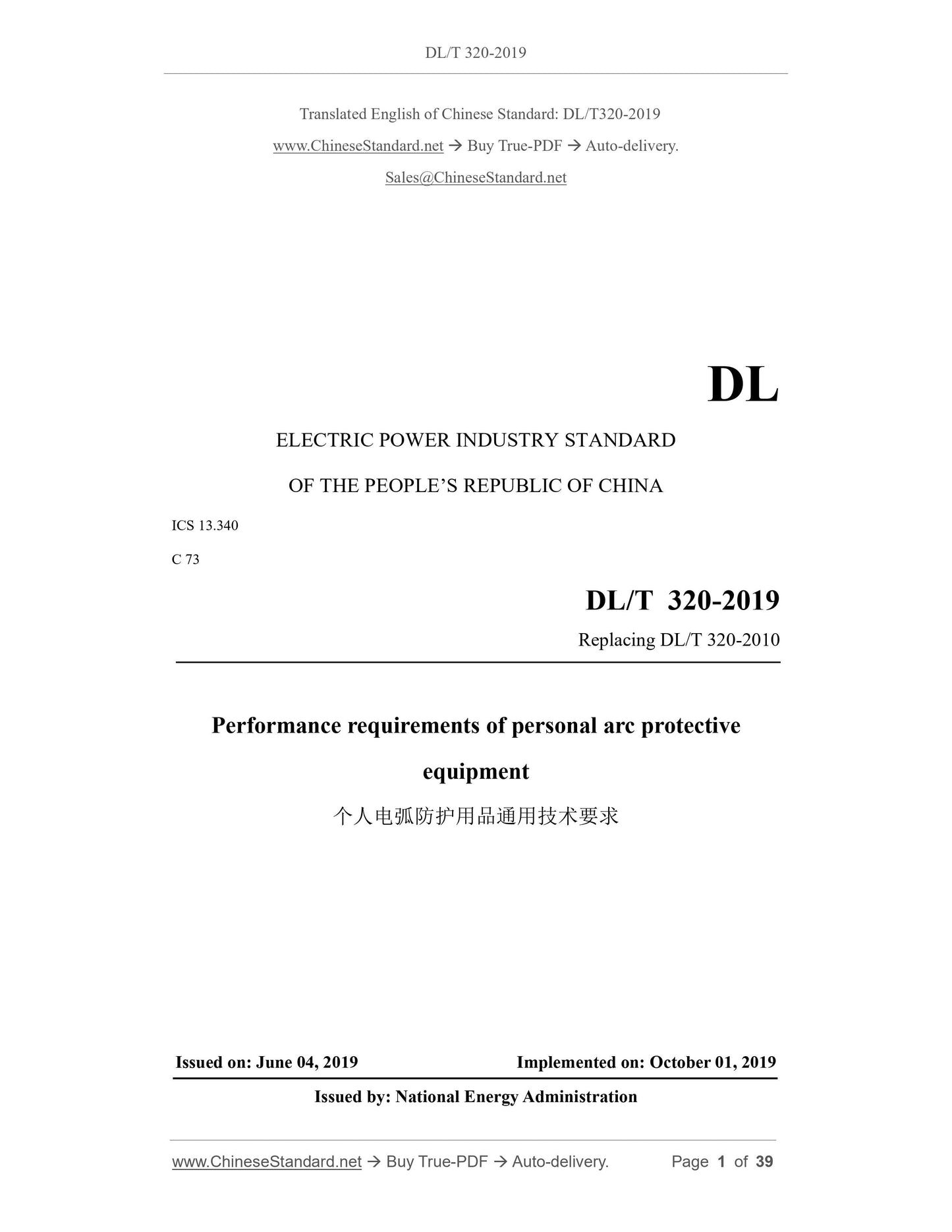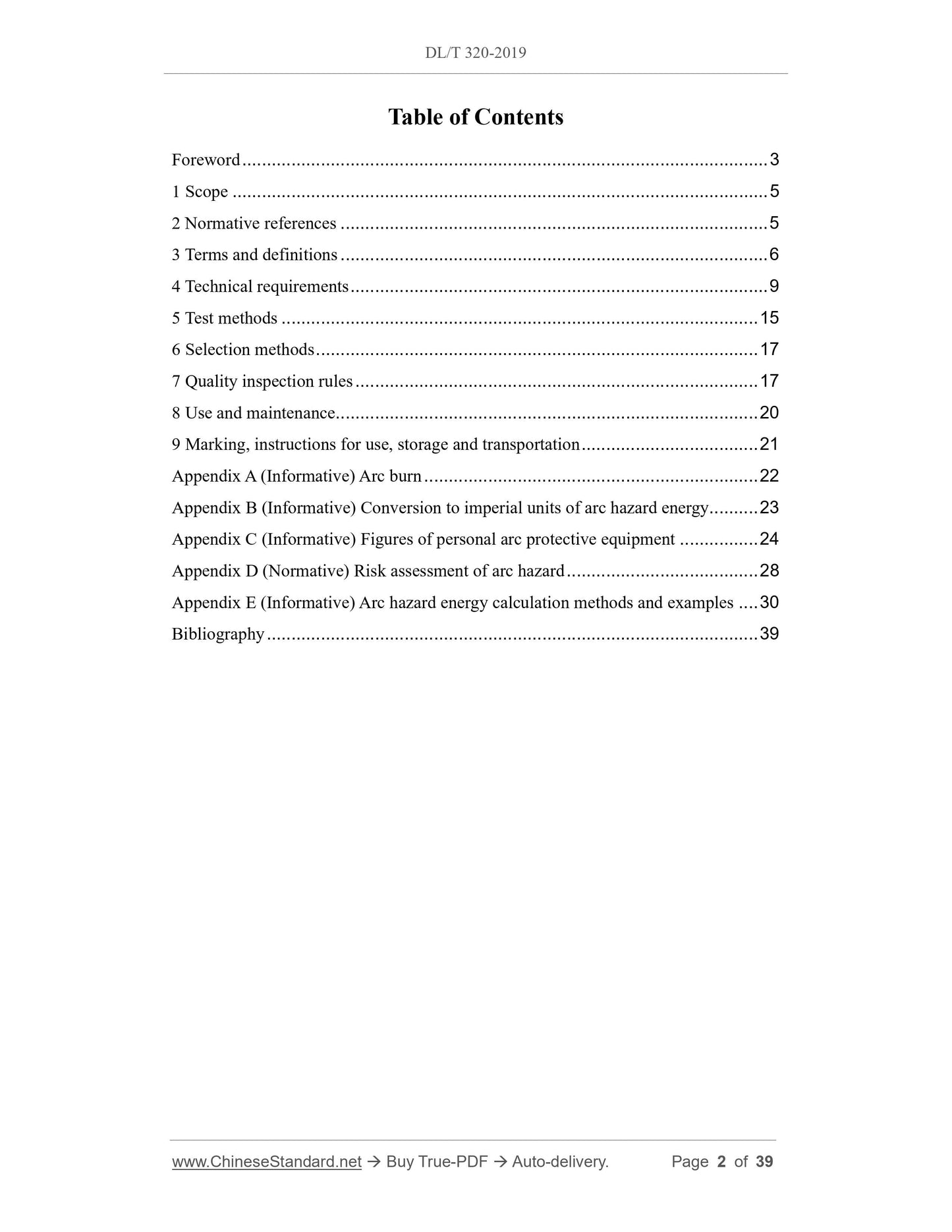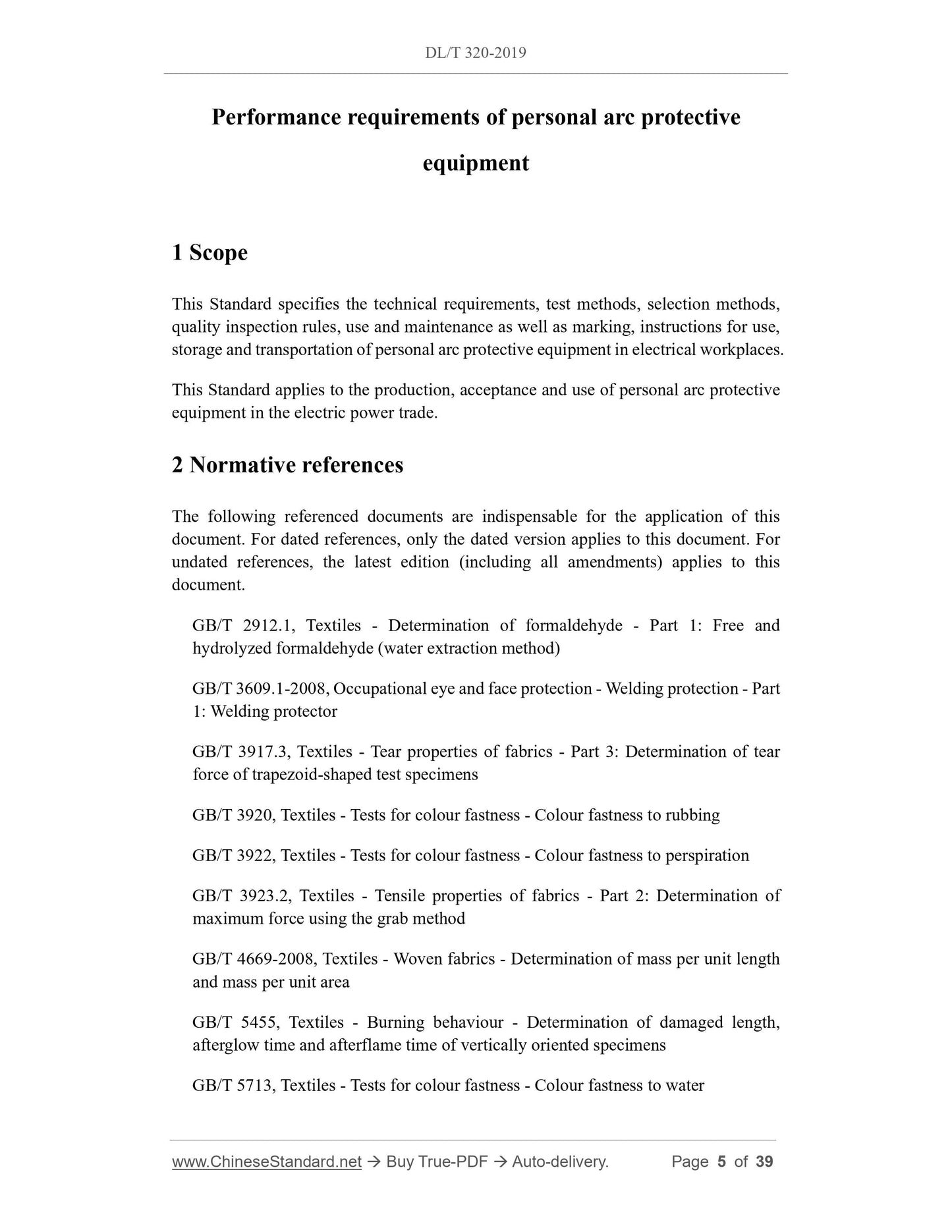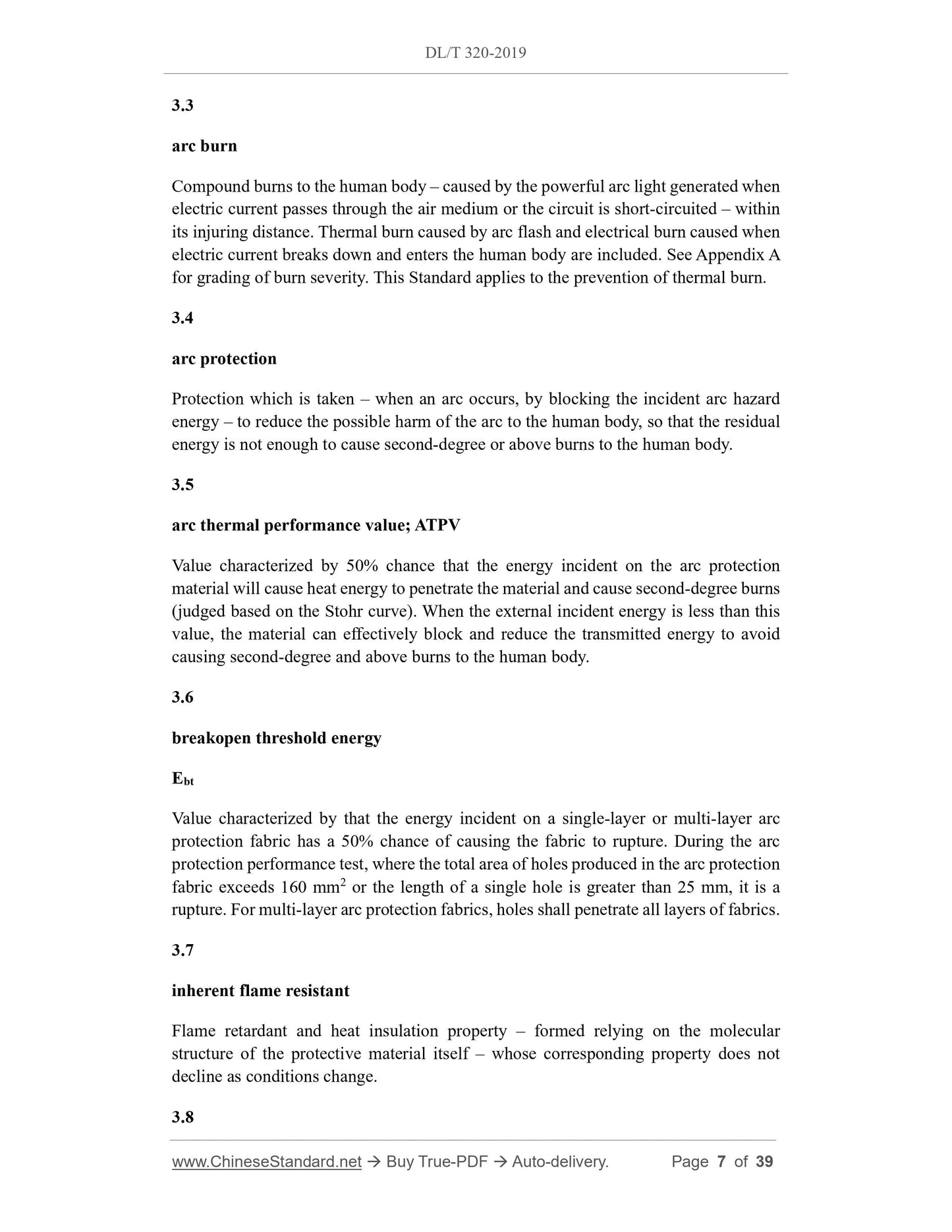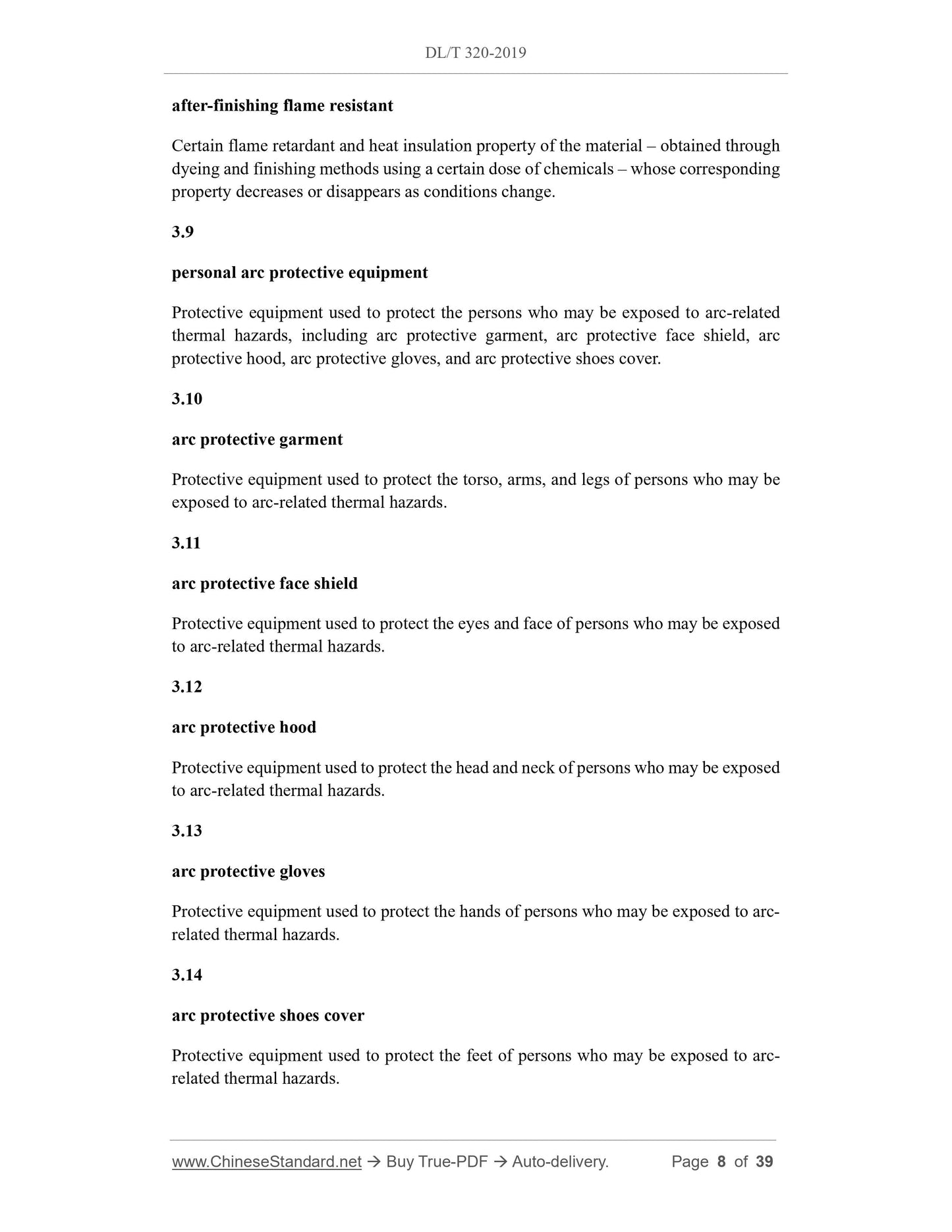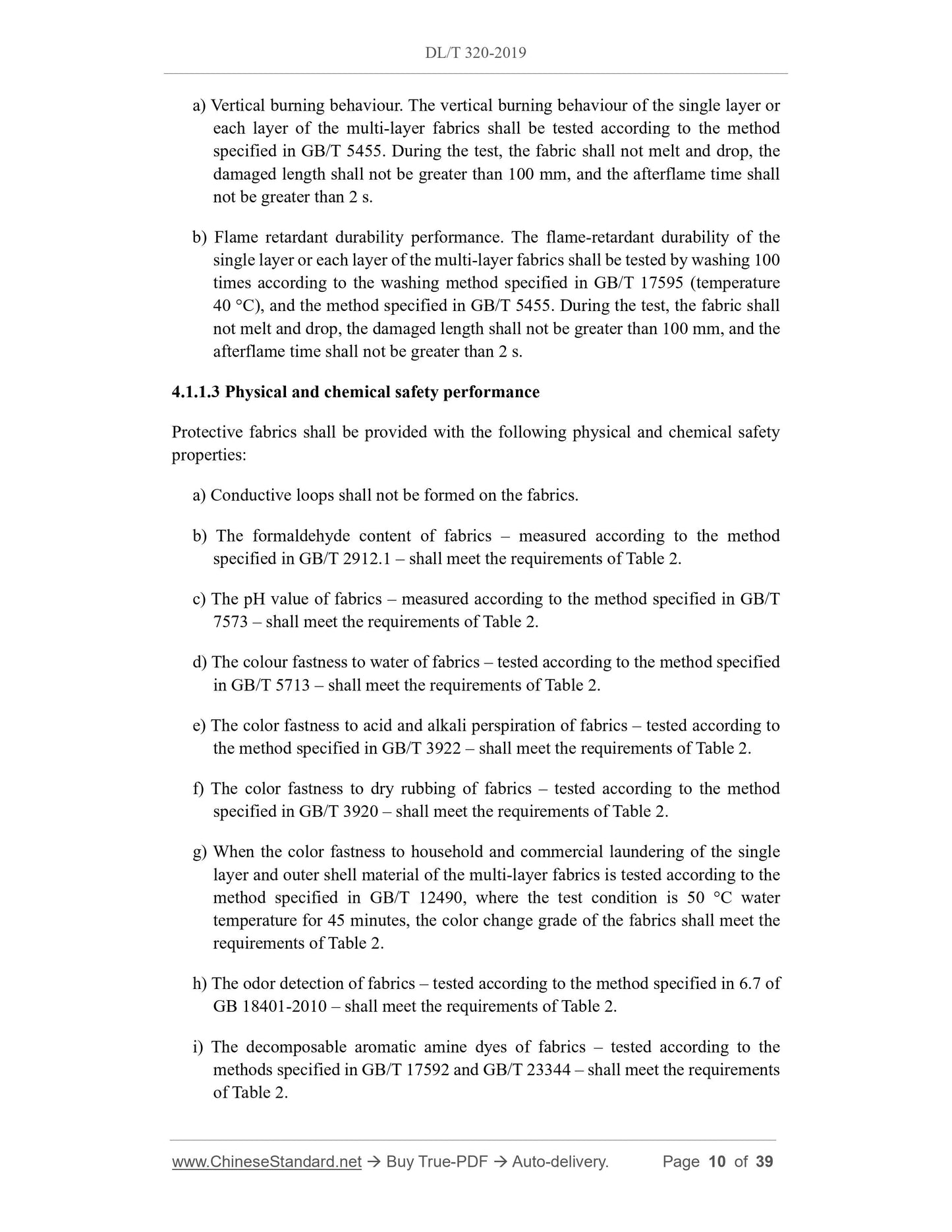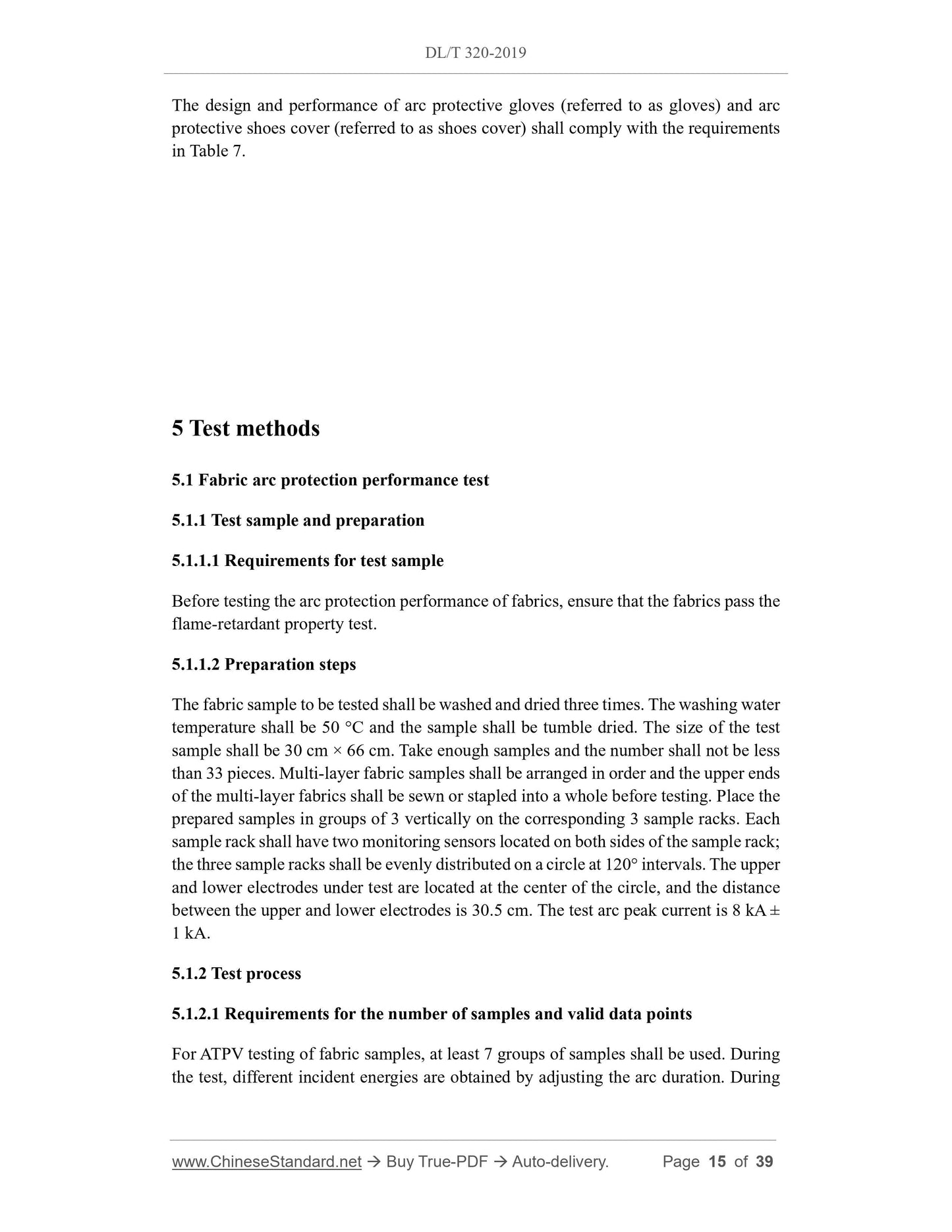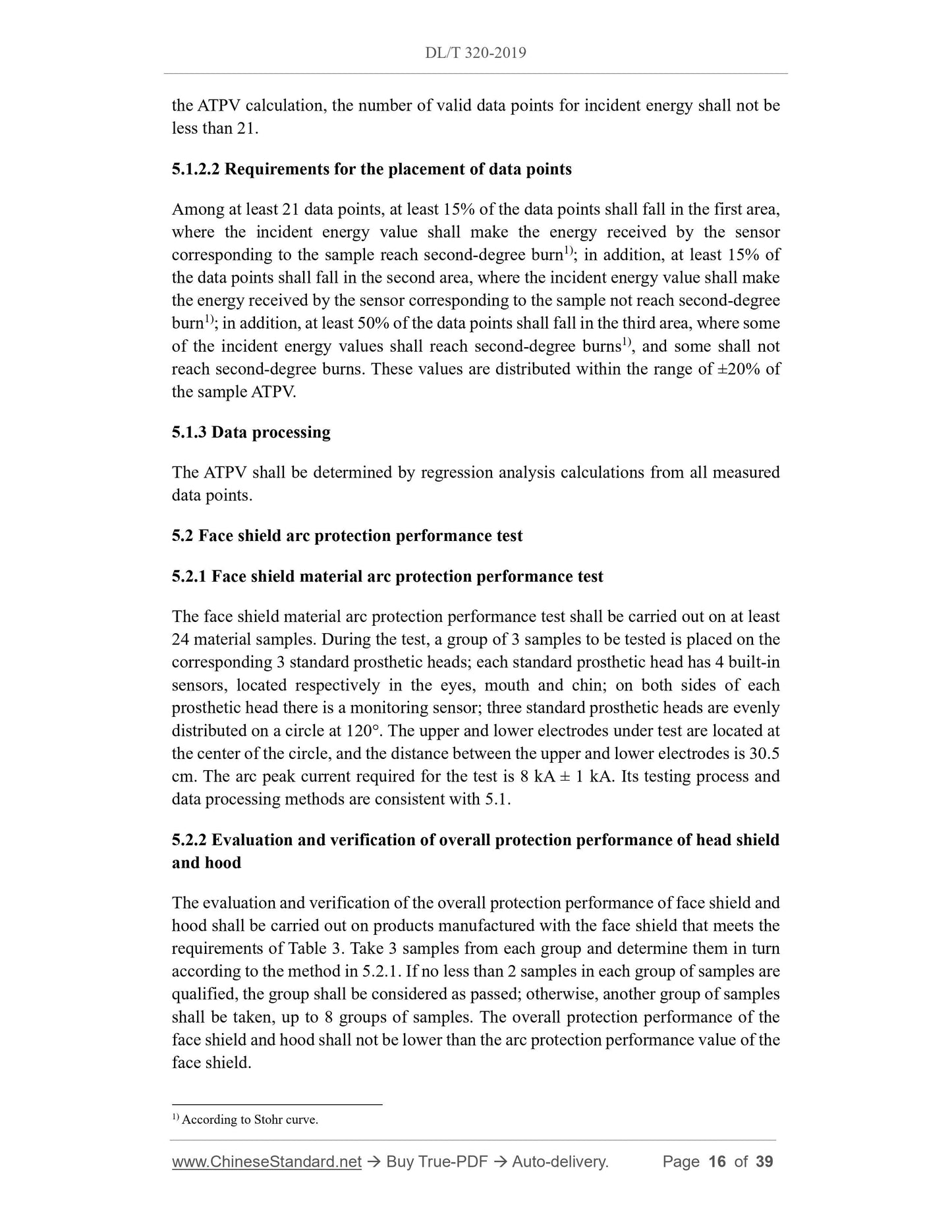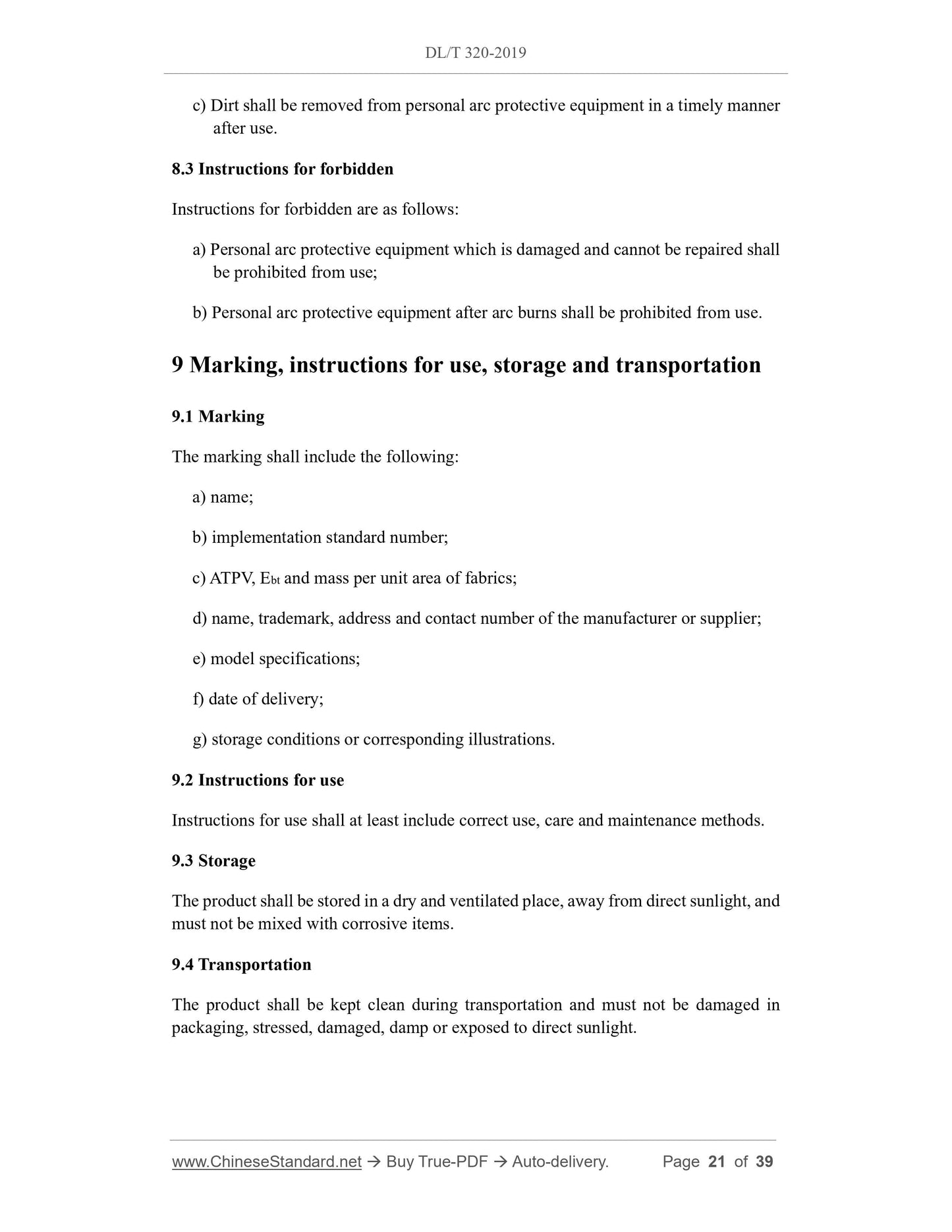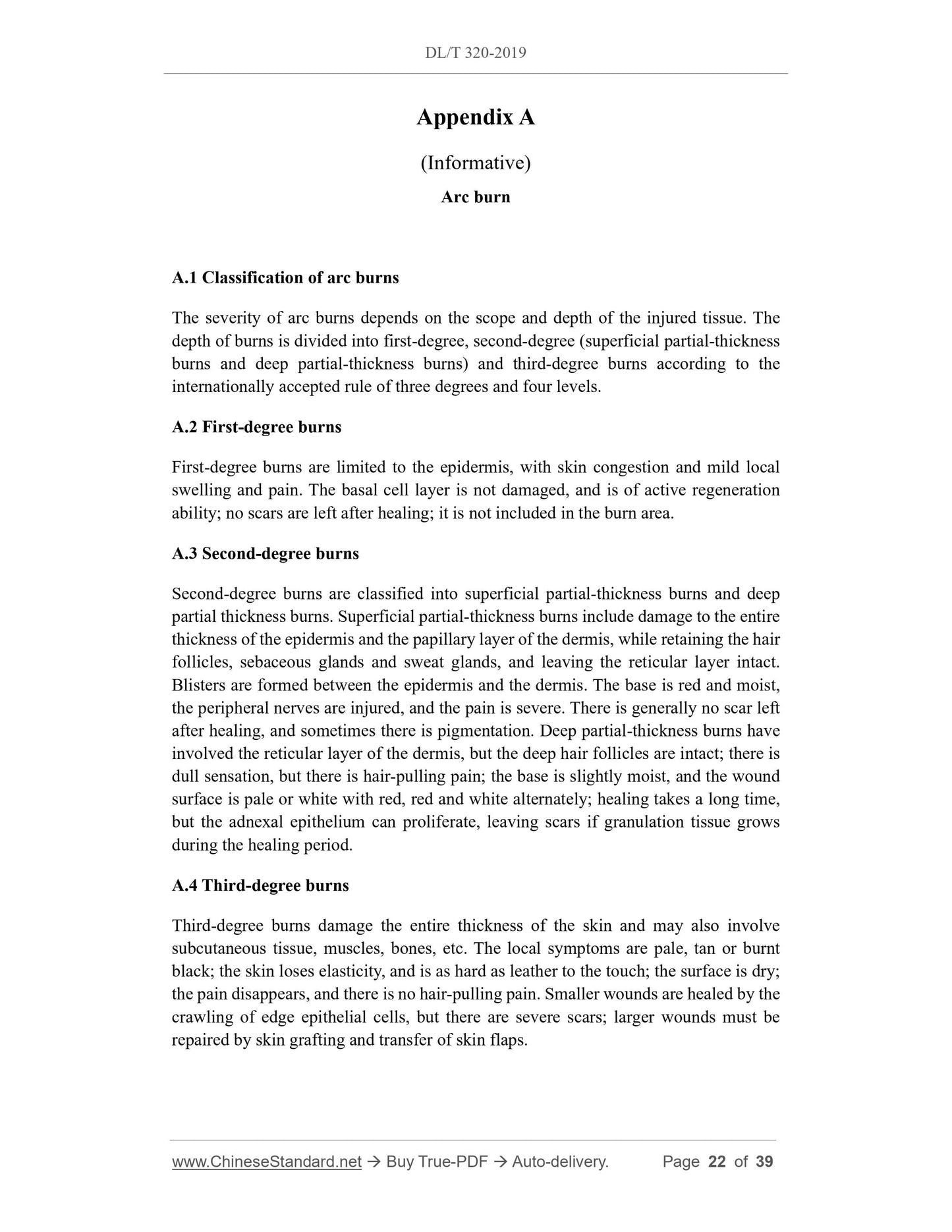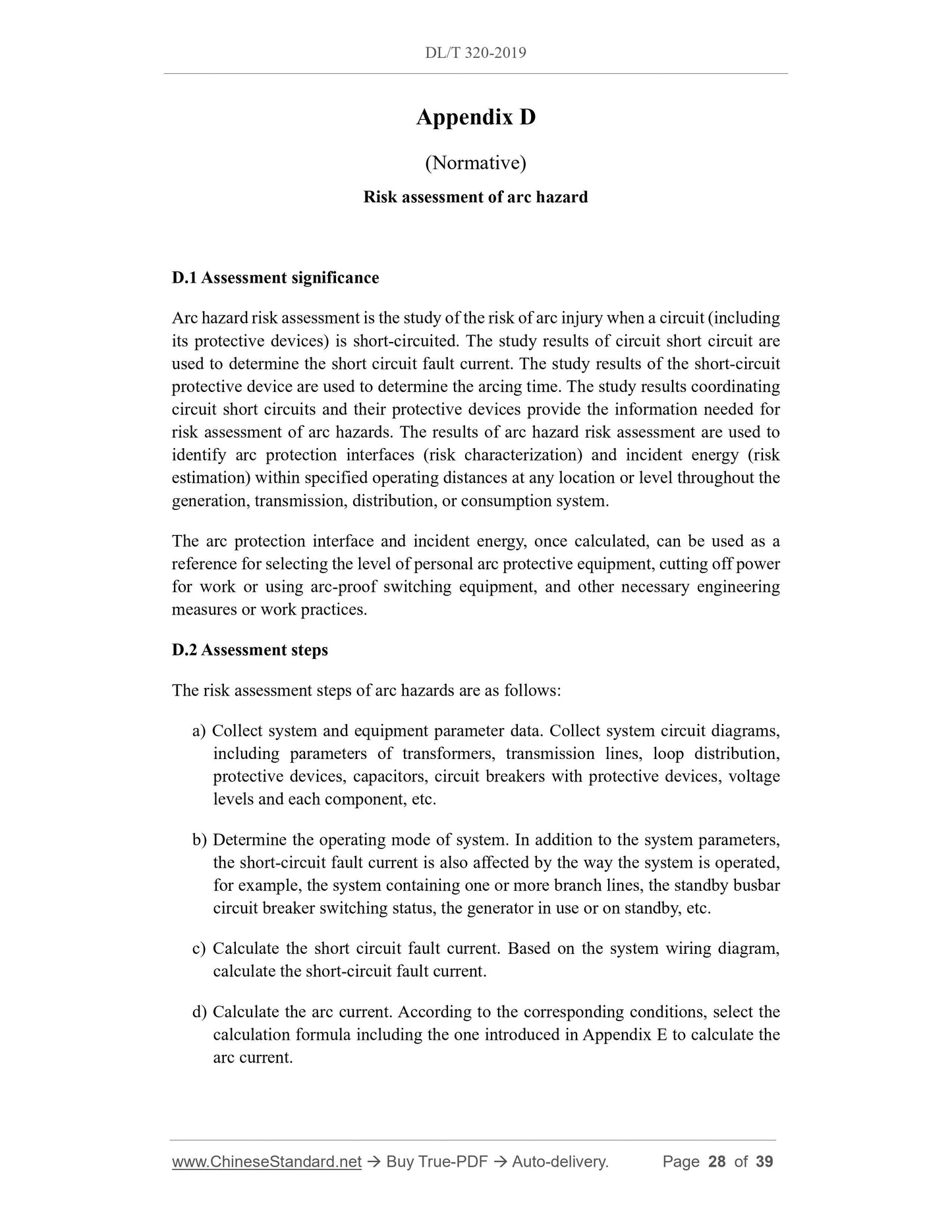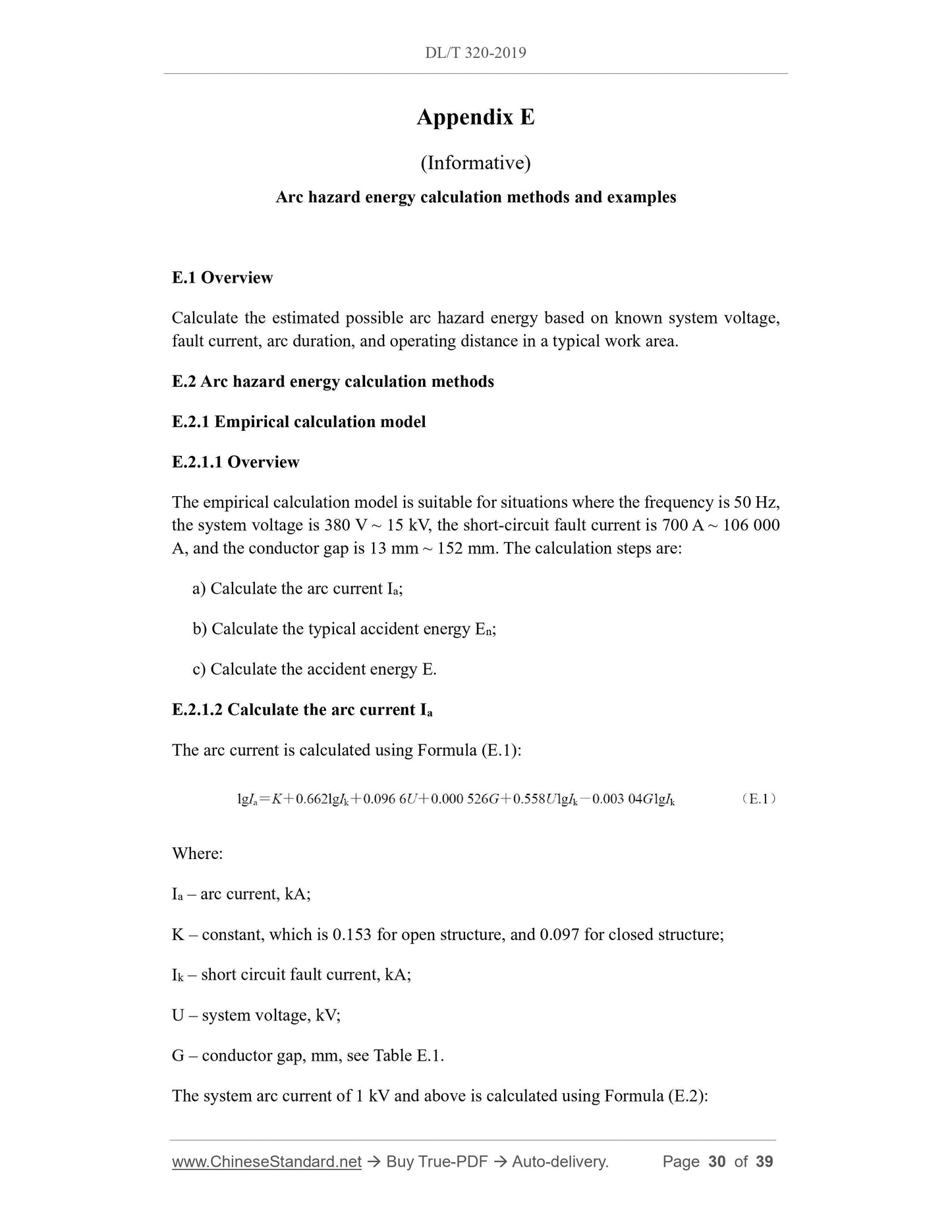1
/
su
12
PayPal, credit cards. Download editable-PDF and invoice in 1 second!
DL/T 320-2019 English PDF (DLT320-2019)
DL/T 320-2019 English PDF (DLT320-2019)
Prezzo di listino
$440.00 USD
Prezzo di listino
Prezzo scontato
$440.00 USD
Prezzo unitario
/
per
Spese di spedizione calcolate al check-out.
Impossibile caricare la disponibilità di ritiro
Delivery: 3 seconds. Download true-PDF + Invoice.
Get QUOTATION in 1-minute: Click DL/T 320-2019
Historical versions: DL/T 320-2019
Preview True-PDF (Reload/Scroll if blank)
DL/T 320-2019: Performance requirements of personal arc protective equipment
DL/T 320-2019
DL
ELECTRIC POWER INDUSTRY STANDARD
OF THE PEOPLE’S REPUBLIC OF CHINA
ICS 13.340
C 73
Replacing DL/T 320-2010
Performance requirements of personal arc protective
equipment
ISSUED ON: JUNE 04, 2019
IMPLEMENTED ON: OCTOBER 01, 2019
Issued by: National Energy Administration
Table of Contents
Foreword ... 3
1 Scope ... 5
2 Normative references ... 5
3 Terms and definitions ... 6
4 Technical requirements ... 9
5 Test methods ... 15
6 Selection methods ... 17
7 Quality inspection rules ... 17
8 Use and maintenance ... 20
9 Marking, instructions for use, storage and transportation ... 21
Appendix A (Informative) Arc burn ... 22
Appendix B (Informative) Conversion to imperial units of arc hazard energy ... 23
Appendix C (Informative) Figures of personal arc protective equipment ... 24
Appendix D (Normative) Risk assessment of arc hazard ... 28
Appendix E (Informative) Arc hazard energy calculation methods and examples ... 30
Bibliography ... 39
Performance requirements of personal arc protective
equipment
1 Scope
This Standard specifies the technical requirements, test methods, selection methods,
quality inspection rules, use and maintenance as well as marking, instructions for use,
storage and transportation of personal arc protective equipment in electrical workplaces.
This Standard applies to the production, acceptance and use of personal arc protective
equipment in the electric power trade.
2 Normative references
The following referenced documents are indispensable for the application of this
document. For dated references, only the dated version applies to this document. For
undated references, the latest edition (including all amendments) applies to this
document.
GB/T 2912.1, Textiles - Determination of formaldehyde - Part 1: Free and
hydrolyzed formaldehyde (water extraction method)
GB/T 3609.1-2008, Occupational eye and face protection - Welding protection - Part
1: Welding protector
GB/T 3917.3, Textiles - Tear properties of fabrics - Part 3: Determination of tear
force of trapezoid-shaped test specimens
GB/T 3920, Textiles - Tests for colour fastness - Colour fastness to rubbing
GB/T 3922, Textiles - Tests for colour fastness - Colour fastness to perspiration
GB/T 3923.2, Textiles - Tensile properties of fabrics - Part 2: Determination of
maximum force using the grab method
GB/T 4669-2008, Textiles - Woven fabrics - Determination of mass per unit length
and mass per unit area
GB/T 5455, Textiles - Burning behaviour - Determination of damaged length,
afterglow time and afterflame time of vertically oriented specimens
GB/T 5713, Textiles - Tests for colour fastness - Colour fastness to water
3.3
arc burn
Compound burns to the human body – caused by the powerful arc light generated when
electric current passes through the air medium or the circuit is short-circuited – within
its injuring distance. Thermal burn caused by arc flash and electrical burn caused when
electric current breaks down and enters the human body are included. See Appendix A
for grading of burn severity. This Standard applies to the prevention of thermal burn.
3.4
arc protection
Protection which is taken – when an arc occurs, by blocking the incident arc hazard
energy – to reduce the possible harm of the arc to the human body, so that the residual
energy is not enough to cause second-degree or above burns to the human body.
3.5
arc thermal performance value; ATPV
Value characterized by 50% chance that the energy incident on the arc protection
material will cause heat energy to penetrate the material and cause second-degree burns
(judged based on the Stohr curve). When the external incident energy is less than this
value, the material can effectively block and reduce the transmitted energy to avoid
causing second-degree and above burns to the human body.
3.6
breakopen threshold energy
Ebt
Value characterized by that the energy incident on a single-layer or multi-layer arc
protection fabric has a 50% chance of causing the fabric to rupture. During the arc
protection performance test, where the total area of holes produced in the arc protection
fabric exceeds 160 mm2 or the length of a single hole is greater than 25 mm, it is a
rupture. For multi-layer arc protection fabrics, holes shall penetrate all layers of fabrics.
3.7
inherent flame resistant
Flame retardant and heat insulation property – formed relying on the molecular
structure of the protective material itself – whose corresponding property does not
decline as conditions change.
3.8
after-finishing flame resistant
Certain flame retardant and heat insulation property of the material – obtained through
dyeing and finishing methods using a certain dose of chemicals – whose corresponding
property decreases or disappears as conditions change.
3.9
personal arc protective equipment
Protective equipment used to protect the persons who may be exposed to arc-related
thermal hazards, including arc protective garment, arc protective face shield, arc
protective hood, arc protective gloves, and arc protective shoes cover.
3.10
arc protective garment
Protective equipment used to protect the torso, arms, and legs of persons who may be
exposed to arc-related thermal hazards.
3.11
arc protective face shield
Protective equipment used to protect the eyes and face of persons who may be exposed
to arc-related thermal hazards.
3.12
arc protective hood
Protective equipment used to protect the head and neck of persons who may be exposed
to arc-related thermal hazards.
3.13
arc protective gloves
Protective equipment used to protect the hands of persons who may be exposed to arc-
related thermal hazards.
3.14
arc protective shoes cover
Protective equipment used to protect the feet of persons who may be exposed to arc-
related thermal hazards.
a) Vertical burning behaviour. The vertical burning behaviour of the single layer or
each layer of the multi-layer fabrics shall be tested according to the method
specified in GB/T 5455. During the test, the fabric shall not melt and drop, the
damaged length shall not be greater than 100 mm, and the afterflame time shall
not be greater than 2 s.
b) Flame retardant durability performance. The flame-retardant durability of the
single layer or each layer of the multi-layer fabrics shall be tested by washing 100
times according to the washing method specified in GB/T 17595 (temperature
40 °C), and the method specified in GB/T 5455. During the test, the fabric shall
not melt and drop, the damaged length shall not be greater than 100 mm, and the
afterflame time shall not be greater than 2 s.
4.1.1.3 Physical and chemical safety performance
Protective fabrics shall be provided with the following physical and chemical safety
properties:
a) Conductive loops shall not be formed on the fabrics.
b) The formaldehyde content of fabrics – measured according to the method
specified in GB/T 2912.1 – shall meet the requirements of Table 2.
c) The pH value of fabrics – measured according to the method specified in GB/T
7573 – shall meet the requirements of Table 2.
d) The colour fastness to water of fabrics – tested according to the method specified
in GB/T 5713 – shall meet the requirements of Table 2.
e) The color fastness to acid and alkali perspiration of fabrics – tested according to
the method specified in GB/T 3922 – s...
Get QUOTATION in 1-minute: Click DL/T 320-2019
Historical versions: DL/T 320-2019
Preview True-PDF (Reload/Scroll if blank)
DL/T 320-2019: Performance requirements of personal arc protective equipment
DL/T 320-2019
DL
ELECTRIC POWER INDUSTRY STANDARD
OF THE PEOPLE’S REPUBLIC OF CHINA
ICS 13.340
C 73
Replacing DL/T 320-2010
Performance requirements of personal arc protective
equipment
ISSUED ON: JUNE 04, 2019
IMPLEMENTED ON: OCTOBER 01, 2019
Issued by: National Energy Administration
Table of Contents
Foreword ... 3
1 Scope ... 5
2 Normative references ... 5
3 Terms and definitions ... 6
4 Technical requirements ... 9
5 Test methods ... 15
6 Selection methods ... 17
7 Quality inspection rules ... 17
8 Use and maintenance ... 20
9 Marking, instructions for use, storage and transportation ... 21
Appendix A (Informative) Arc burn ... 22
Appendix B (Informative) Conversion to imperial units of arc hazard energy ... 23
Appendix C (Informative) Figures of personal arc protective equipment ... 24
Appendix D (Normative) Risk assessment of arc hazard ... 28
Appendix E (Informative) Arc hazard energy calculation methods and examples ... 30
Bibliography ... 39
Performance requirements of personal arc protective
equipment
1 Scope
This Standard specifies the technical requirements, test methods, selection methods,
quality inspection rules, use and maintenance as well as marking, instructions for use,
storage and transportation of personal arc protective equipment in electrical workplaces.
This Standard applies to the production, acceptance and use of personal arc protective
equipment in the electric power trade.
2 Normative references
The following referenced documents are indispensable for the application of this
document. For dated references, only the dated version applies to this document. For
undated references, the latest edition (including all amendments) applies to this
document.
GB/T 2912.1, Textiles - Determination of formaldehyde - Part 1: Free and
hydrolyzed formaldehyde (water extraction method)
GB/T 3609.1-2008, Occupational eye and face protection - Welding protection - Part
1: Welding protector
GB/T 3917.3, Textiles - Tear properties of fabrics - Part 3: Determination of tear
force of trapezoid-shaped test specimens
GB/T 3920, Textiles - Tests for colour fastness - Colour fastness to rubbing
GB/T 3922, Textiles - Tests for colour fastness - Colour fastness to perspiration
GB/T 3923.2, Textiles - Tensile properties of fabrics - Part 2: Determination of
maximum force using the grab method
GB/T 4669-2008, Textiles - Woven fabrics - Determination of mass per unit length
and mass per unit area
GB/T 5455, Textiles - Burning behaviour - Determination of damaged length,
afterglow time and afterflame time of vertically oriented specimens
GB/T 5713, Textiles - Tests for colour fastness - Colour fastness to water
3.3
arc burn
Compound burns to the human body – caused by the powerful arc light generated when
electric current passes through the air medium or the circuit is short-circuited – within
its injuring distance. Thermal burn caused by arc flash and electrical burn caused when
electric current breaks down and enters the human body are included. See Appendix A
for grading of burn severity. This Standard applies to the prevention of thermal burn.
3.4
arc protection
Protection which is taken – when an arc occurs, by blocking the incident arc hazard
energy – to reduce the possible harm of the arc to the human body, so that the residual
energy is not enough to cause second-degree or above burns to the human body.
3.5
arc thermal performance value; ATPV
Value characterized by 50% chance that the energy incident on the arc protection
material will cause heat energy to penetrate the material and cause second-degree burns
(judged based on the Stohr curve). When the external incident energy is less than this
value, the material can effectively block and reduce the transmitted energy to avoid
causing second-degree and above burns to the human body.
3.6
breakopen threshold energy
Ebt
Value characterized by that the energy incident on a single-layer or multi-layer arc
protection fabric has a 50% chance of causing the fabric to rupture. During the arc
protection performance test, where the total area of holes produced in the arc protection
fabric exceeds 160 mm2 or the length of a single hole is greater than 25 mm, it is a
rupture. For multi-layer arc protection fabrics, holes shall penetrate all layers of fabrics.
3.7
inherent flame resistant
Flame retardant and heat insulation property – formed relying on the molecular
structure of the protective material itself – whose corresponding property does not
decline as conditions change.
3.8
after-finishing flame resistant
Certain flame retardant and heat insulation property of the material – obtained through
dyeing and finishing methods using a certain dose of chemicals – whose corresponding
property decreases or disappears as conditions change.
3.9
personal arc protective equipment
Protective equipment used to protect the persons who may be exposed to arc-related
thermal hazards, including arc protective garment, arc protective face shield, arc
protective hood, arc protective gloves, and arc protective shoes cover.
3.10
arc protective garment
Protective equipment used to protect the torso, arms, and legs of persons who may be
exposed to arc-related thermal hazards.
3.11
arc protective face shield
Protective equipment used to protect the eyes and face of persons who may be exposed
to arc-related thermal hazards.
3.12
arc protective hood
Protective equipment used to protect the head and neck of persons who may be exposed
to arc-related thermal hazards.
3.13
arc protective gloves
Protective equipment used to protect the hands of persons who may be exposed to arc-
related thermal hazards.
3.14
arc protective shoes cover
Protective equipment used to protect the feet of persons who may be exposed to arc-
related thermal hazards.
a) Vertical burning behaviour. The vertical burning behaviour of the single layer or
each layer of the multi-layer fabrics shall be tested according to the method
specified in GB/T 5455. During the test, the fabric shall not melt and drop, the
damaged length shall not be greater than 100 mm, and the afterflame time shall
not be greater than 2 s.
b) Flame retardant durability performance. The flame-retardant durability of the
single layer or each layer of the multi-layer fabrics shall be tested by washing 100
times according to the washing method specified in GB/T 17595 (temperature
40 °C), and the method specified in GB/T 5455. During the test, the fabric shall
not melt and drop, the damaged length shall not be greater than 100 mm, and the
afterflame time shall not be greater than 2 s.
4.1.1.3 Physical and chemical safety performance
Protective fabrics shall be provided with the following physical and chemical safety
properties:
a) Conductive loops shall not be formed on the fabrics.
b) The formaldehyde content of fabrics – measured according to the method
specified in GB/T 2912.1 – shall meet the requirements of Table 2.
c) The pH value of fabrics – measured according to the method specified in GB/T
7573 – shall meet the requirements of Table 2.
d) The colour fastness to water of fabrics – tested according to the method specified
in GB/T 5713 – shall meet the requirements of Table 2.
e) The color fastness to acid and alkali perspiration of fabrics – tested according to
the method specified in GB/T 3922 – s...
Share
